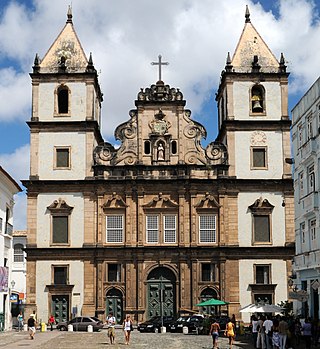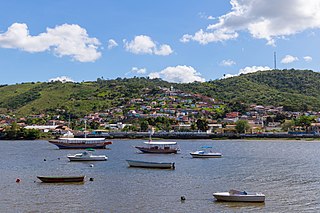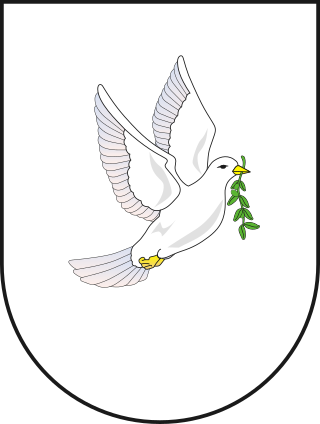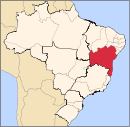
Caramuru was the Tupi name of the Portuguese colonist Diogo Álvares Correia, who is notable for being the first European to establish contact with the native Tupinambá population in modern-day Brazil and was instrumental in the early colonization of Brazil by the Portuguese crown. Notably, Caramuru's native-born wife, Catarina Paraguaçu, was the first South American native to be received at the Palace of Versailles in 1526. He and Catarina would become the first Christian family in Brazil and have three children: Gaspar, Gabriel and Jorge, all named knights by Tomé de Sousa.

Itaparica is an island located at the entrance of Todos os Santos Bay on the coast of the Atlantic Ocean in the state of Bahia, Brazil. It is located about 10 kilometres (6.2 mi) from the city of Salvador, Bahia and covers 146 square kilometres (56 sq mi). There are two municipalities on the island: Vera Cruz and Itaparica (13%). Itaparica has 40 kilometres (25 mi) of beaches and exuberant tropical vegetation.

The Archdiocese of São Salvador da Bahia is part of the Roman Catholic Church in Brazil. The Archbishop of São Salvador da Bahia also carries the title Primate of Brazil. The archdiocese is located in the city of Salvador, Bahia.

The São Francisco Church and Convent of Salvador is located in the historical centre of Salvador, in the State of Bahia, Brazil. The ornate Church of the Third Order of Saint Francis sits adjacent to the convent. The friars of the Franciscan Order arrived in Salvador in 1587 and constructed a convent and church on the site. This structure was destroyed by the Dutch during the Dutch invasions of Bahia in the next century; Father Vicente das Chagas initiated the current structure in 1686, which was completed in the 18th century. The Franciscan church and convent have the largest number of azulejos, 55,000, of any church in Latin America.

Barra is a neighborhood located in the south zone of the city of Salvador, Bahia, Brazil. Barra is one of the most traditional neighborhoods of the city, and is also one of the most popular neighborhoods for tourists, with many attractions, like Farol da Barra Lighthouse, Morro do Cristo Hill, Farol da Barra Beach, and Porto da Barra Beach.

The Historic Center (US) or Centre (UK) of Salvador de Bahia in Brazil, also known as the Pelourinho or Pelo, is a historic neighborhood in western Salvador, Bahia. It was the city's center during the Portuguese colonial period and was named for the whipping post in its central plaza where enslaved people from Africa were publicly beaten as punishment for alleged infractions. The Historic Center is extremely rich in historical monuments dating from the 17th through the 19th centuries.
Candeias is a municipality in Brazil, in the state of Bahia. It is located 46 kilometres (29 mi) to the north of Salvador, the capital of Bahia. The town is near the BR-324 motorway. The town has a current population of 87,458.

Itaparica is a municipality located in the Brazilian island of the same name in the state of Bahia. The municipality covers 13% of the island; the remainder belongs to the municipality of Vera Cruz. The municipality of Itaparica has a population of is 22,337 and covers an area of 115.922 square kilometres (44.758 sq mi).

São Francisco do Conde is a municipality in the state of Bahia in the North-East region of Brazil. São Francisco do Conde covers 262.856 km2 (101.489 sq mi), and has a population of 40,245 with a population density of 150 inhabitants per square kilometer. It is located 67 kilometres (42 mi) from the state capital of Salvador. According to the Brazilian Institute of Geography and Statistics São Francisco do Conde has the highest concentration of Brazilians of African descent (90%) in Bahia.

Jaguaripe is a municipality in the state of Bahia in the North-East region of Brazil. It covers 863.424 km2 (333.370 sq mi), and has a population of 18,981 with a population density of 18.32 inhabitants per square kilometer. Jaguaripe is located 130 km (81 mi) from the state capital of Bahia, Salvador. Jaguaripe shares a border with the municipalities of Aratuípe, Nazaré, Maragogipe, Laje, São Miguel das Matas, and Santo Antônio de Jesus. It was the first municipality created outside of Salvador, dating to 1693.

São Félix, Bahia is a municipality in Bahia, Brazil. The municipality has a population of 14,762 with a population density of 142 inhabitants per square kilometer. It is located 110 km (68 mi) from the state capital of Bahia, Salvador.

Catarina Álvares Paraguaçu, also known as Catarina do Brasil, was a Brazilian Tupinambá Indian. She was born in what is today the state of Bahia and was married to Portuguese sailor Diogo Álvares Correia, also known as "Caramuru". She and Caramuru became the first Brazilian Christian family.

The Captaincy of Bahia, fully the Captaincy of the Bay of All Saints, was a captaincy of Portuguese Brazil.
Maria Filipa de Oliveira was an Afro-Brazilian independence fighter, and is consisted a controversial figure. She is believed to be from island of Itaparica, Bahia, and was active during the Brazilian War of Independence. The independence struggle against the Portuguese lasted a little over a year, with many battles centered on Itaparica. Maria Filipa is noted as one of three women who participated in the struggle for Bahia's independence in 1823, the others being the military figure Maria Quitéria (1792-1853) and Sister Joana Angélica (1761-1822).

The Chapel of Our Lady of Help is a 20th-century Roman Catholic church in Salvador, Bahia, Brazil. It sits on the site of a church of the same name built by the Jesuits in 1549, one of the first in Brazil. The present church was designed by the Italian architect Julio Conti in the Neo-Manueline style and consecrated in 1932. It is owned by the Roman Catholic Archdiocese of São Salvador da Bahia, is dedicated to Our Lady of Help, and houses numerous original works of art of the early colonial period. The Chapel of Our Lady of Help was listed as a historic structure by National Institute of Historic and Artistic Heritage (IPHAN) in 1938 and is part of the Historic Center of Salvador UNESCO World Heritage Site.

The Church of Saint Lawrence is a 17th-century Roman Catholic church located in Itaparica, Bahia, Brazil. The church is dedicated to Saint Lawrence, the patron saint of the island of Itaparica. It was built early in the Portuguese settlement of Brazil as part of the plantation of Gabriel Soares de Sousa. The Church of Saint Lawrence was listed as a historic structure by National Institute of Historic and Artistic Heritage (IPHAN) in 1952. 90% of the collection of religious objects and images were stolen from the church in 2010; they were never recovered.

The Chapel of Our Lady of the Ladder is a 16th-century Roman Catholic church located in Salvador, Bahia, Brazil. It was constructed as part of the Nossa Senhora de Escada sugar plantation by Lázaro Arévolo, likely in 1566; he donated the chapel to the Jesuits in the late 16th century. The chapel is part of the Roman Catholic Archdiocese of São Salvador da Bahia; it was listed as a historic structure by the National Institute of Historic and Artistic Heritage (IPHAN) in 1962. It and the Church and Monastery of Our Lady of Monserrate are the only remaining 16th-century chapels in Salvador.

José Teófilo de Jesus was a Brazilian painter and gilder. He is the most noted representative of the Escola Baiana or Bahian School of painting. His work was eclectic, characterized by the passage from the Baroque to the Rococo, with reference to Neoclassical traits. De Jesus was of pardo, or mixed ethnic ancestry and lived into his nineties; little else is known of his life. His production was apparently vast, but many of his works are only identified by oral tradition. Although he is known as one of the great names of the Brazilian Baroque, and one of its final artists, details of his life and a full account of his works remain unclear.

Ilha dos Frades is an island in the Bay of All Saints. It is administered as part of the city of Salvador in the state of Bahia. The island is located in the center of the bay. It is 6 kilometres (3.7 mi) in length, covers 1.335 hectares, and shaped like a fifteen-pointed star. Ilha dos Frades has preserved vegetation of the Atlantic Forest, including native Brazil wood. The island is protected as part of the Environmental Protection Area of the Bay of All Saints.

The Church and Monastery of Our Lady of Grace is an 18th-century Roman Catholic church located in Salvador, Bahia, Brazil. The church is dedicated to Our Lady of Grace and is part of the Roman Catholic Archdiocese of São Salvador da Bahia; it is owned and managed by the Mosteiro de São Bento. It was listed as a historic structure by the National Historic and Artistic Heritage Institute (IPHAN) in 1938.





















